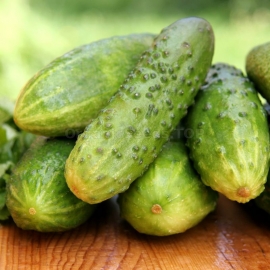
«Game» - Organic Cucumber Seeds
1.14 €
This is a mid-season variety for open ground. The vegetation period from germination to fruiting 48-52 days. Duration of fruiting is 30-35 days. Fruits are dark green, tuberculate, elongated-oval in shape, 10-12 cm long, 70-80g in weight, good taste.
-
Ukrainian Heirloom Cucumber «Game»
This is a mid-season variety for open ground. The vegetation period from germination to fruiting 48-52 days. Duration of fruiting is 30-35 days.
Fruits are dark green, tuberculate, elongated-oval in shape, 10-12 cm long, 70-80g in weight, good taste. The variety is relatively resistant to downy mildew and bacteriosis. Used for fresh consumption, salting and preservation.
Planting Tips for Heirloom Cucumbers
Growing in the greenhouse
Start cucumbers off by sowing seeds from mid-February to mid-March if you have a heated greenhouse or similar environment, or in April if you have an unheated greenhouse. Sow seeds on their side, 1cm (½in) deep in pots.
Sowing outdoors
Sow seeds 2.5cm (1in) deep indoors in late April. Alternatively, sow directly outside in late May or early June and cover the soil above the seeds with fleece, a cloche or glass jar. This method can work well in southern regions and in warm summers. Young plants are also available from garden centres in spring.
Grow
Growing indoorsTransfer young plants to 25cm (10in) pots of good potting compost in late March (heated greenhouse), late May (unheated greenhouse). Keep the compost evenly moist – little and often is the best way. You can also use growing-bags but plants will need to be carefully watered and looked after.
Train the main stem up a vertical wire or cane. Pinch out the growing point when it reaches the roof. Pinch out the tips of sideshoots two leaves beyond a female flower (recognisable by tiny fruits behind flower). Pinch out the tips of flowerless sideshoots once they reach 60cm (2ft) long. Keep the humidity high by watering the floor and, once planted out, feed every 10-14 days with a balanced liquid fertiliser.
Growing outdoors
Either sow seeds or plant out young plants in early June, ideally under fleece or cloches. Any fertile garden soil in full sun is satisfactory. Dig in up to two bucketfuls of rotted organic matter, such as garden compost, and rake in 100g per square metre (3½oz per square yard) of general purpose fertiliser.
Pinch out the growing tip when the plants have developed seven leaves. The developing sideshoots can be left to trail over the ground or trained up stout netting. Pinch out the tips of flowerless sideshoots after seven leaves. Don't remove the male flowers, and keep the soil constantly moist by watering around the plants – not over them.
